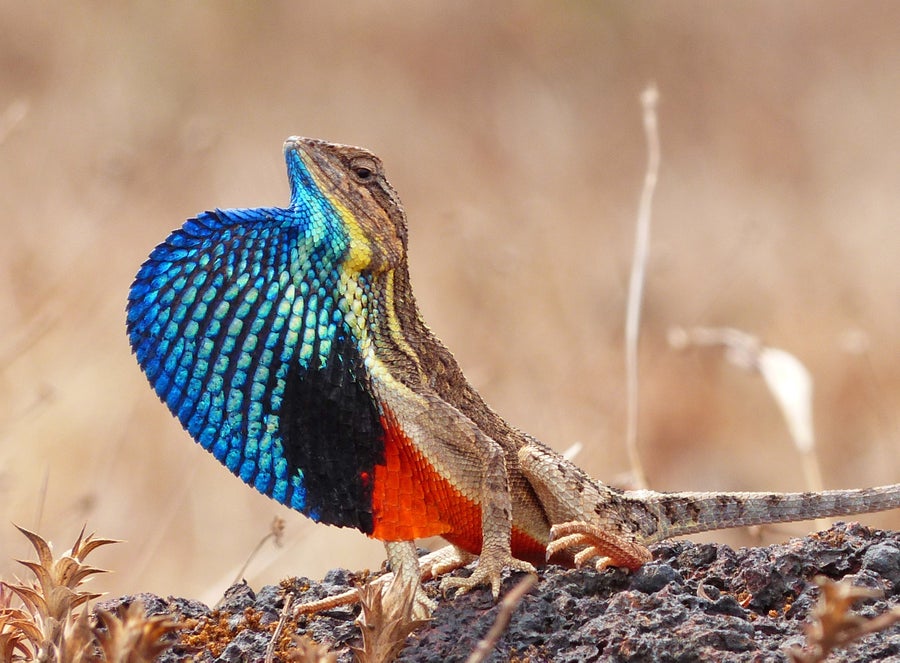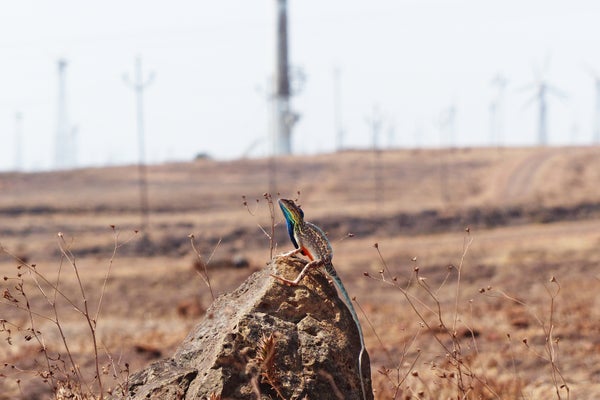Wind farms are popping up all over the world. In the U.S. alone wind power capacity has tripled over the last decade. Although this trend is good news for efforts to curtail emissions and climate change, a growing body of research suggests wind turbines disturb their local environment in a significant way. Scientists have documented, for example, turbines killing hundreds of thousands of birds and bats.
Now a new study has found wind energy also influences ecosystems indirectly, via changes that trickle down through the food web: Like tigers, great white sharks and humans, wind turbines can function as apex predators.
But researchers stress that even though wind energy has ecological impacts, we should still use it. After all, fossil fuels upset the environment in a much more profound way. Rather than criticizing wind power the scientists involved say their work is intended to help people make better-informed decisions about how and where they use clean energy.
On supporting science journalism
If you're enjoying this article, consider supporting our award-winning journalism by subscribing. By purchasing a subscription you are helping to ensure the future of impactful stories about the discoveries and ideas shaping our world today.
Top Predators
Wind farms have operated in the Western Ghats mountain range, a biodiversity hotspot in India, for about two decades. The location was a perfect place for researcher Maria Thaker and her colleagues to study how turbines affect the local ecosystem. Their work, published last week in Nature Ecology & Evolution, found birds were four times scarcer and hunted food less in zones with wind farms than in those without. But this was not because birds were flying into turbine blades and dying, the researchers say. “We could see the birds come up to the edge of the wind farm and then fly away,” says Thaker, a professor of ecology at the Indian Institute of Science’s Center for Ecological Sciences. “It was straight-up avoidance.”

The health and population size of the lizards was affected by the absence of birds near wind turbines. Credit: Abi Vanak
Thaker and her team then assessed the population of a certain lizard species the birds typically prey on. They counted the lizards, took blood samples to measure stress levels and analyzed body condition and coloration. (Males have a brightly colored flap of skin beneath their jaws, which they use for sexual communication). The scientists also recorded the lizards’ sensitivity to predators—how closely the researchers could approach them without the animals running away.
Not surprisingly, the researchers found a greater lizard population in areas with wind turbines, because there were fewer birds. “We fully expected that when you have a loss of top predators, the density of prey will increase,” Thaker says. These lizards were also less wary of predators and had lower stress levels than their counterparts outside the range of the turbines.
The rest of their results, however, were unexpected. Even though lizards living with the turbines were under less pressure from predators, they were skinnier and less colorful than members of their species living elsewhere. This may sound counterintuitive, but Thaker says it makes sense ecologically. “The high competition for food meant that the quality of each individual was actually reduced,” she notes. “That's the nuance of what happens when you remove the top predator.”
Beyond how wind turbines affect this lizard species, the study has a bigger point: It indicates wind farms can create a cascade of unintended effects within an ecosystem by essentially acting like top predators. “This man-made structure has removed a layer in the food web. That’s what a top predator does—it takes out the layer below it,” Thaker says. “By taking out the layer below it, the layer below that one is released from pressure.”
In the Western Ghats case this effect may even spiral beyond the lizards to the insects they eat as well as plants connected to the local food web. Wind turbines could potentially trigger this cascade effect in other ecosystems around the planet, especially ones with simpler food webs, Thaker says.
Clean Energy Implications
These ecological impacts are just one way wind farms can disturb the environment. The most obvious signs of trouble, which emerged years ago, were the large numbers of birds and bats killed by turbine collisions—or by air pressure changes associated with the turbines. Turbines are believed to kill between 140,000 and 500,000 birds each year in the U.S. The estimate for bats is even higher: One study puts the nation’s total between 651,000 and 888,000 deaths per year. Of course, those numbers seem relatively small when compared with the number of birds that die after flying into buildings—an estimated 365 million to 988 million each year in the U.S. alone. And according to one study, fossil-fueled power plants in this country kill about 24 million birds a year.
In addition to direct collisions, scientists have also observed other indirect effects—such as several species of birds being displaced by wind turbines. There is also evidence some mammals avoid areas with wind turbines or have higher stress levels when near them, Thaker says.“We know that there’s quite a wide variety of adverse or negative effects that wind farms can have on wildlife,” says Scott Loss, an assistant professor of global change ecology and management at Oklahoma State University who was not involved in the new study. This may occur on a larger ecological scale as well. “Wind turbines fragment [the landscape], change the soundscape and airspace, and can change the amount of human activity—all these things can change the habitat,” notes Todd Katzner, a research wildlife biologist with the U.S. Geological Survey who did not take part in the work. Studies have also found that turbines can change the local temperature by mixing up the atmosphere.
But some experts say the latest study by Thaker and her team takes research on the effects of wind energy in a new and interesting direction. “This study is really cool in that it's the first I'm aware of that’s suggesting an effect across more than one [food chain] level,” Loss says. Katzner agrees, “They're highlighting a topic that’s really important and that we don’t know much about at all,” he says. “This study could have important consequences for our understanding of wind energy’s effects on individual species and community-level population dynamics.”
Both Thaker and outside experts emphasize this does not mean we should demonize or get rid of wind energy. “All types of energy extraction have environmental consequences,” Katzner notes. And wind energy has important environmental benefits: Operating turbines emit no greenhouse gases and do not require water, for instance. Thaker says she still supports clean energy over fossil fuels because climate change poses a threat to species and ecosystems all over the world. “I'm by no means suggesting not to use clean energy,” she says. “That's not the message of my paper.”
Instead, Thaker suggests decision makers seriously consider wind energy’s ecological effects when deciding where to build them. “New wind farms should be put in environments that are not particularly unique, that are not rich in biodiversity, so that we can minimize the impacts,” she says. “We cannot be blind to the fact that impacts do exist.”
